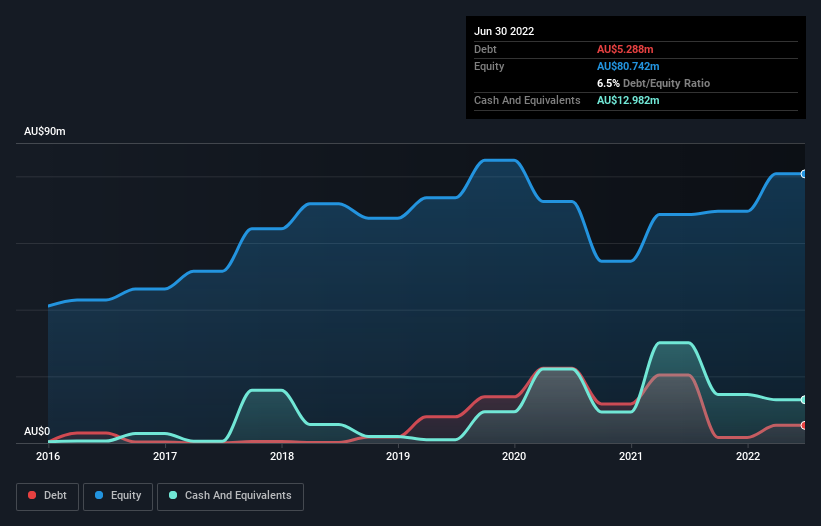
The external fund manager backed by Berkshire Hathaway's Charlie Munger, Li Lu, makes no bones about it when he says 'The biggest investment risk is not the volatility of prices, but whether you will suffer a permanent loss of capital.' When we think about how risky a company is, we always like to look at its use of debt, since debt overload can lead to ruin. Importantly, Clean Seas Seafood Limited (ASX:CSS) does carry debt. But the more important question is: how much risk is that debt creating?
When Is Debt A Problem?
Debt is a tool to help businesses grow, but if a business is incapable of paying off its lenders, then it exists at their mercy. If things get really bad, the lenders can take control of the business. However, a more frequent (but still costly) occurrence is where a company must issue shares at bargain-basement prices, permanently diluting shareholders, just to shore up its balance sheet. Of course, the upside of debt is that it often represents cheap capital, especially when it replaces dilution in a company with the ability to reinvest at high rates of return. When we examine debt levels, we first consider both cash and debt levels, together.
Our analysis indicates that CSS is potentially undervalued!
What Is Clean Seas Seafood's Debt?
As you can see below, Clean Seas Seafood had AU$5.29m of debt at June 2022, down from AU$20.4m a year prior. However, it does have AU$13.0m in cash offsetting this, leading to net cash of AU$7.69m.

How Healthy Is Clean Seas Seafood's Balance Sheet?
We can see from the most recent balance sheet that Clean Seas Seafood had liabilities of AU$15.3m falling due within a year, and liabilities of AU$3.39m due beyond that. Offsetting this, it had AU$13.0m in cash and AU$5.30m in receivables that were due within 12 months. So its liabilities outweigh the sum of its cash and (near-term) receivables by AU$435.0k.
This state of affairs indicates that Clean Seas Seafood's balance sheet looks quite solid, as its total liabilities are just about equal to its liquid assets. So while it's hard to imagine that the AU$89.4m company is struggling for cash, we still think it's worth monitoring its balance sheet. While it does have liabilities worth noting, Clean Seas Seafood also has more cash than debt, so we're pretty confident it can manage its debt safely.
Although Clean Seas Seafood made a loss at the EBIT level, last year, it was also good to see that it generated AU$9.1m in EBIT over the last twelve months. The balance sheet is clearly the area to focus on when you are analysing debt. But ultimately the future profitability of the business will decide if Clean Seas Seafood can strengthen its balance sheet over time. So if you want to see what the professionals think, you might find this free report on analyst profit forecasts to be interesting.
Finally, while the tax-man may adore accounting profits, lenders only accept cold hard cash. While Clean Seas Seafood has net cash on its balance sheet, it's still worth taking a look at its ability to convert earnings before interest and tax (EBIT) to free cash flow, to help us understand how quickly it is building (or eroding) that cash balance. Over the last year, Clean Seas Seafood recorded negative free cash flow, in total. Debt is far more risky for companies with unreliable free cash flow, so shareholders should be hoping that the past expenditure will produce free cash flow in the future.
Summing Up
While it is always sensible to look at a company's total liabilities, it is very reassuring that Clean Seas Seafood has AU$7.69m in net cash. So we are not troubled with Clean Seas Seafood's debt use. When analysing debt levels, the balance sheet is the obvious place to start. But ultimately, every company can contain risks that exist outside of the balance sheet. Be aware that Clean Seas Seafood is showing 2 warning signs in our investment analysis , and 1 of those is a bit concerning...
If, after all that, you're more interested in a fast growing company with a rock-solid balance sheet, then check out our list of net cash growth stocks without delay.
New: AI Stock Screener & Alerts
Our new AI Stock Screener scans the market every day to uncover opportunities.
• Dividend Powerhouses (3%+ Yield)
• Undervalued Small Caps with Insider Buying
• High growth Tech and AI Companies
Or build your own from over 50 metrics.
Have feedback on this article? Concerned about the content? Get in touch with us directly. Alternatively, email editorial-team (at) simplywallst.com.
This article by Simply Wall St is general in nature. We provide commentary based on historical data and analyst forecasts only using an unbiased methodology and our articles are not intended to be financial advice. It does not constitute a recommendation to buy or sell any stock, and does not take account of your objectives, or your financial situation. We aim to bring you long-term focused analysis driven by fundamental data. Note that our analysis may not factor in the latest price-sensitive company announcements or qualitative material. Simply Wall St has no position in any stocks mentioned.
About ASX:CSS
Clean Seas Seafood
Operates in the aquaculture industry in Australia, Europe, North America, Asia, and internationally.
Mediocre balance sheet low.
Similar Companies
Market Insights
Community Narratives



